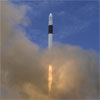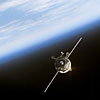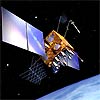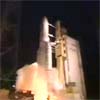|
News Archive: March 1-31 |

|
Planets found thriving around stellar twins
The double sunset that Luke Skywalker gazed upon in the film "Star Wars" might not be a fantasy. NASA's Spitzer Space Telescope has observed that planetary systems are at least as abundant in twin-star systems as they are in those, like our own, with only one star. Sunsets on some of those worlds would resemble the ones on Luke Skywalker's planet, Tatooine, where two fiery balls dip below the horizon one by one.
 FULL STORY FULL STORY
 |  |

|
 |
Did dust bust the 2006 hurricane season forecasts?
A recent NASA study suggests that tiny dust particles may have foiled forecasts that the 2006 hurricane season would be another active one. In June and July 2006, there were several significant dust storms over the Sahara Desert in Africa. As this dust traveled westward into the Atlantic, satellite data show that the particles blocked sunlight from reaching the ocean surface, causing ocean waters to cool.
 FULL STORY FULL STORY
 |  |

|
 |
Station crew moves its Russian Soyuz capsule
The three International Space Station residents left their orbital home Thursday, taking a brief excursion aboard the Russian Soyuz capsule to clear a docking port for the arrival of the next crew in April.
 FULL STORY FULL STORY
 |  |

|
 |

Additional coverage for subscribers:
 VIDEO:
WATCH THE SOYUZ RELOCATION TRIP PLAY VIDEO:
WATCH THE SOYUZ RELOCATION TRIP PLAY
 SUBSCRIBE NOW SUBSCRIBE NOW

|
OTHER HEADLINES Additional stories today
|
 |
NASA astronaut to run Boston Marathon in space -- NASA astronaut Suni Williams will go faster than anyone has ever gone in the Boston Marathon. She will run the famed race in April as an official entrant from 210 miles above Earth aboard the International Space Station. This will be the first time an astronaut in space will be an official participant in a marathon.

Anomalous behaviour affects Vega firing test -- The second firing test of the solid rocket motor that will power the third stage of ESA's future small launcher Vega took place this week. But a problem occurred during the firing.

NASA studies how airborne particles affect climate change -- A recent NASA study links natural and human-made aerosol particles to how much Earth warms or cools. Earth's atmosphere acts as a protective shield that regulates how much solar energy the planet absorbs or deflects.
|
 |
SpaceX gives update on Falcon test flight results
The following is a statement from SpaceX founder Elon Musk concerning the post-flight review of data gathered from the Falcon 1 rocket's recent test launch.
 FULL STORY FULL STORY
 |  |

|
 |
Three-dimension medical imaging reaches the stars
A unique collaboration created by Harvard's Initiative for Innovative Computing has brought together astronomers, medical imaging specialists, and software engineers to adapt medical imaging software to create 3-D views of astronomical bodies.
 FULL STORY FULL STORY
 |  |

|
 |
Rhea: Orb of ice
A serene orb of ice is set against the gentle pastel clouds of giant Saturn in this Cassini spacecraft image. Rhea transits the face of the gas giant, whose darkened rings and their planet-hugging shadows appear near upper right.
 FULL STORY FULL STORY
 |  |

|
 |
Unusual Hyperion
Chaotically tumbling and seriously eroded by impacts, Hyperion is one of Saturn's more unusual satellites. Scientists believe the moon to be quite porous, with a great deal of its volume being empty space. Cassini took this image of the moon.
 FULL STORY FULL STORY
 |  |

|
 |
Cassini images bizarre hexagon on giant Saturn
An odd, six-sided, honeycomb-shaped feature circling the entire north pole of Saturn has captured the interest of scientists with the Cassini mission. "This is a very strange feature, lying in a precise geometric fashion with six nearly equally straight sides," says one team member. "We've never seen anything like this on any other planet.
 FULL STORY FULL STORY
 |  |

|
 |
International Space Station supply ship undocks
The Russian Progress 23P cargo freighter, certain to be remembered as the resupply ship with a troublesome antenna that required an intervention by spacewalkers, safely left the International Space Station on Tuesday for its fiery re-entry into the atmosphere.
 FULL STORY FULL STORY
 |  |

|
 |

Additional coverage for subscribers:
 VIDEO:
THE PROGRESS 23P SHIP UNDOCKS PLAY VIDEO:
THE PROGRESS 23P SHIP UNDOCKS PLAY
 VIDEO:
EXPEDITION 14 RECAP BRIEFING PLAY VIDEO:
EXPEDITION 14 RECAP BRIEFING PLAY
 VIDEO:
EXPEDITION 15 PRE-FLIGHT BRIEFING PLAY VIDEO:
EXPEDITION 15 PRE-FLIGHT BRIEFING PLAY
 SUBSCRIBE NOW SUBSCRIBE NOW

|
Global 'sunscreen' has likely thinned, NASA says
A new NASA study has found that an important counter-balance to the warming of our planet by greenhouse gases - sunlight blocked by dust, pollution and other aerosol particles - appears to have lost ground.
 FULL STORY FULL STORY
 |  |

|
 |
Robotic telescope unravels mystery of cosmic blasts
Scientists have used the world's largest robotic telescope to make the earliest-ever measurement of the optical polarization of a gamma ray burst just 203 seconds after the start of the cosmic explosion. This finding, which provides new insight into GRB physics, was published in Science.
 FULL STORY FULL STORY
 |  |

|
 |
Italian astronaut focuses on complex mission
Later this year European Space Agency astronaut Paolo Nespoli will serve as a mission specialist on the STS-120 mission to the International Space Station. Together with the rest of the shuttle crew, Nespoli is training intensively ahead of this complex ISS assembly mission.
 FULL STORY FULL STORY
 |  |

|
 |
Launch of European-made station cargo freighter slips
A European craft designed to ferry science experiments, fuel and other supplies to the international space station will launch this fall, several months later than originally planned, officials said last week.
 FULL STORY FULL STORY
 |  |

|
 |
Lockheed completes work on modernized GPS craft
Lockheed Martin announced the delivery of the eighth and final satellite in the modernized Global Positioning System Block 2R (GPS 2R-M) production program to the Air Force.
 FULL STORY FULL STORY
 |  |

|
 |
Shuttle crew assigned for Japanese lab launch
NASA has assigned the crew for space shuttle mission STS-124, targeted for launch in February 2008. The flight will deliver the Pressurized Module and robotic arm of the Japanese Experiment Module, known as Kibo, to the International Space Station.
 FULL STORY FULL STORY
 |  |

|
 |
Enceladus geysers mask the length of Saturn's day
In a David and Goliath story of Saturnian proportions, the little moon Enceladus is weighing down giant Saturn's magnetic field so much that the field is rotating slower than the planet. This phenomenon makes it nearly impossible to measure the length of the Saturn day using techniques that work at the other giant planets.
 FULL STORY FULL STORY
 |  |

|
 |
Interplanetary supply chain
If you think shipping freight from Cincinnati to El Paso is challenging, imagine trying to deliver an oxygen generation unit from the Earth to a remote location on the moon. By 2020, NASA plans to establish a long-term human presence on the moon, potentially centered on an outpost to be built at the rim of the Shackleton crater near the lunar South Pole.
 FULL STORY FULL STORY
 |  |

|
 |
NASA holds off on making shuttle tank decision
NASA is pressing ahead with work to repair the shuttle Atlantis's hail-damaged external fuel tank in hopes of getting the orbiter off on a space station assembly mission before the current launch window closes in late May, officials said Wednesday.
 FULL STORY FULL STORY
 |  |

|
 |
International spacecraft gives new view of the sun
NASA released on Wednesday never-before-seen images that show the sun's magnetic field is much more turbulent and dynamic than previously known. The international spacecraft Hinode, formerly known as Solar B, took the images.
 FULL STORY FULL STORY
 |  |

|
 |
Falcon rocket flies to space but misses orbit
The Falcon 1 rocket, a gleaming symbol of hopes to revolutionize space exploration through private industry, took its second shot at orbit Tuesday night but fell back to Earth after experiencing a problem mid-way through the ascent.
 FULL STORY FULL STORY
 MISSION STATUS CENTER - updates MISSION STATUS CENTER - updates
 TRANSCRIPT OF POST-LAUNCH NEWS BRIEFING TRANSCRIPT OF POST-LAUNCH NEWS BRIEFING
 IMAGES: LAUNCH PHOTO GALLERY IMAGES: LAUNCH PHOTO GALLERY
 |  |

|
 |
Oldest GPS satellite being prepared for disposal
The oldest operational satellite in the GPS constellation has broadcast its signal for more than 16 years, during which time that signal's mission applications -- and the people who make sure the signal is available -- have changed dramatically.
 FULL STORY FULL STORY
 |  |

|
 |
CryoSat on the road to recovery after launch failure
Building a satellite in just three years is without doubt an ambitious undertaking. Nevertheless, the decision to rebuild CryoSat and recover the mission includes just that goal. A year on and the mission is now well on the way to recovery, with a design that incorporates no less than 85 separate improvements.
 FULL STORY FULL STORY
 |  |

|
 |
OTHER HEADLINES Additional stories today
|
 |
Embry-Riddle students rocketing into history -- A group of students from Embry-Riddle Aeronautical University, Fla., are spending their spring break traveling 800 miles in an attempt to make history. They have planned, designed, fabricated, tested and are now preparing to stage and launch their own suborbital rocket -- Icarus.

ESA takes steps toward quantum communications -- A team of European scientists has proved within an ESA study that the weird quantum effect called entanglement remains intact over a distance of 144 kilometres. The experiment allows ESA to take a step closer to exploiting entanglement as a way of communicating with satellites with total security.
|
 |
KBO broken up by massive impact 4.5 billion years ago
In the outer reaches of the solar system, there is an object known as 2003 EL61 that looks like and spins like a football being drop-kicked over the proverbial goalpost of life. New findings could make it one of the most important of the Kuiper-belt objects for understanding the workings of the solar system.
 FULL STORY FULL STORY
 |  |

|
 |
Mission to return sample from Near-Earth Object
A menacing lump of rock and dust in space called 1999 RQ36 would barely be noticed except for two crucial facts: it's a treasure trove of organic material and it regularly crosses Earth's orbit, so it might impact us someday.
 FULL STORY FULL STORY
 |  |

|
 |
Mars' south pole ice found to be deep and wide
New measurements of Mars' south polar region indicate extensive frozen water. The polar region contains enough frozen water to cover the whole planet in a liquid layer approximately 36 feet deep. A joint NASA-Italian Space Agency instrument on the European Space Agency's Mars Express spacecraft provided these data.
 FULL STORY FULL STORY
 |  |

|
 |
Students name space station connecting hub
The space station's connecting module that will serve as the gateway to international science laboratories has been given a name -- Harmony -- following a nationwide contest for schoolchildren.
 FULL STORY FULL STORY
 |  |

|
 |

Additional coverage for subscribers:
 VIDEO:
MODULE'S NAME UNVEILED IN CEREMONY WITH CREW PLAY VIDEO:
MODULE'S NAME UNVEILED IN CEREMONY WITH CREW PLAY
 SUBSCRIBE NOW SUBSCRIBE NOW

|
Hail-damaged shuttle fuel tank assessment continues
Senior NASA managers, including agency Administrator Mike Griffin, plan to meet late next week to assess the shuttle Atlantis's hail-damaged external tank, what will be needed to repair it and when the shuttle, originally scheduled for launch March 15, might be able to take off on a space station assembly mission.
 FULL STORY FULL STORY
 |  |

|
 |
Rover churns up questions with sulfur-rich soil
Some bright Martian soil containing lots of sulfur and a trace of water intrigues researchers who are studying information provided by NASA's Spirit rover.
 FULL STORY FULL STORY
 |  |

|
 |

Additional coverage for subscribers:
 VIDEO:
ANIMATED FLYOVER OF SPIRIT'S WORKSITE PLAY VIDEO:
ANIMATED FLYOVER OF SPIRIT'S WORKSITE PLAY
 VIDEO:
ANIMATED FLYOVER OF OPPORTUNITY AT VICTORIA CRATER PLAY VIDEO:
ANIMATED FLYOVER OF OPPORTUNITY AT VICTORIA CRATER PLAY
 SUBSCRIBE NOW SUBSCRIBE NOW

|
A midnight plume on Io
This is another dramatic picture of Jupiter's moon Io and its volcanic plumes taken by the New Horizons spacecraft during the recent close approach with the giant planet. The continuing eruption of the volcano Tvashtar, at the 1 o'clock position, produces an enormous plume roughly 200 miles high, which is illuminated both by sunlight and "Jupiter light."
 FULL STORY FULL STORY
 |  |

|
 |
Cluster opens new window on near-Earth space
Plasma physicists have made an unprecedented measurement in their study of the Earth's magnetic field. Thanks to the European Space Agency's Cluster satellites they detected an electric field thought to be a key element in the process of "magnetic reconnection."
 FULL STORY FULL STORY
 |  |

|
 |
Cassini images seas on Saturn's moon Titan
Instruments on NASA's Cassini spacecraft have found evidence for seas, likely filled with liquid methane or ethane, in the high northern latitudes of Saturn's moon Titan. One such feature is larger than any of the Great Lakes of North America and is about the same size as several seas on Earth.
 FULL STORY FULL STORY
 |  |

|
 |

Additional coverage for subscribers:
 VIDEO:
ANIMATION AND INTERVIEW ON TITAN DISCOVERY PLAY VIDEO:
ANIMATION AND INTERVIEW ON TITAN DISCOVERY PLAY
 SUBSCRIBE NOW SUBSCRIBE NOW

|
OTHER HEADLINES Additional stories today
|
 |
Craft to study clouds at edge of space arrives at Vandenberg -- NASA's Aeronomy of Ice in the Mesosphere (AIM) spacecraft arrived Saturday at Vandenberg Air Force Base, Calif., for a targeted April 25 launch aboard a Pegasus XL rocket.

ISS module from Japan arrives at NASA for launch -- After traveling thousands of miles, a major component of the International Space Station is set to begin preparations for launch. The Experiment Logistics Module Pressurized Section for the Japanese Experiment Module arrived at NASA's Kennedy Space Center in Florida early Monday.

NASA studies true colors of evergreen rain forests -- NASA satellites reveal that Amazon forests are neither evergreen nor dependent on constant rain, and are capable of manufacturing their seasons. Researchers report a 25 percent increase in the amount of green leaf area during the dry season when the skies are relatively clear.

New form of matter-antimatter transformation -- Whilst science fiction toys effortlessly with anti-matter, in reality it can be very hard to produce, so researchers around the world are celebrating a new break through in this area. The new observation will be used as a test of the Standard Model, the current theory that best describes the entire universe's luminous matter and its associated forces.
|
 |
Safety analysis needed to clear shuttle's tank repairs
Amid ongoing inspections of the shuttle Atlantis' hail-damaged external fuel tank, engineers are optimistic they can make unprecedented repairs at the Kennedy Space Center, avoiding a lengthy launch delay to late June.
 FULL STORY FULL STORY
 |  |

|
 |

Additional coverage for subscribers:
 VIDEO:
WORKERS GAIN ACCESS FOR TANK INSPECTIONS PLAY VIDEO:
WORKERS GAIN ACCESS FOR TANK INSPECTIONS PLAY
 MORE:
STS-117 VIDEO COVERAGE MORE:
STS-117 VIDEO COVERAGE
 SUBSCRIBE NOW SUBSCRIBE NOW

|
A hot start might explain geysers on Enceladus
A hot start billions of years ago might have set into motion the forces that power geysers on Saturn's moon Enceladus. A new model suggests the rapid decay of radioactive elements within Enceladus shortly after it formed may have jump-started the long-term heating of the moon's interior that continues today.
 FULL STORY FULL STORY
 |  |

|
 |
Panorama reveals more than a thousand black holes
By casting a wide net, astronomers have captured an image of more than a thousand supermassive black holes. These results give astronomers a snapshot of a crucial period when these monster black holes are growing, and provide insight into the environments in which they occur.
 FULL STORY FULL STORY
 |  |

|
 |
British and Indian satellites fly to space on Ariane 5
A brilliant flash of light and a roar of thunderous sound signaled the start of Arianespace's first space launch of the year Sunday evening, and the rocket's two communications payloads were delivered to orbit just a half-hour later.
 FULL STORY FULL STORY
 MISSION STATUS CENTER MISSION STATUS CENTER
 |  |

|
 |
Solar power at play
For the very first time, astronomers have witnessed the speeding up of an asteroid's rotation, and have shown that it is due to a theoretical effect predicted but never seen before. The international team of scientists used an armada of telescopes to discover that the asteroid's rotation period currently decreases by 1 millisecond every year, as a consequence of the heating of the asteroid's surface by the Sun. Eventually it may spin faster than any known asteroid in the solar system and even break apart.
 FULL STORY FULL STORY
 |  |

|
 |
Gamma-ray birth cries suggest magnetic engines
Several times a week, astronomers detect the violent death cry of a massive star -- an extraordinarily energetic release of gamma rays that takes place in just a matter of seconds to minutes, called a gamma-ray burst. The GRB's ejecta, which is thought to be beamed in narrow jets, slams into interstellar gas at near light speed.
 FULL STORY FULL STORY
 |  |

|
 |
XMM-Newton finds leader of magnificent seven in spin
A decade-long mystery has been solved using data from ESA's X-ray observatory XMM-Newton. The brightest member of the so-called 'magnificent seven' has been found to pulsate with a period of seven seconds. The discovery casts some doubt on the recent interpretation that this object is a highly exotic celestial object known as a quark star.
 FULL STORY FULL STORY
 |  |

|
 |
Cluster of military payloads launches on Atlas 5 rocket
The Atlas 5 rocket's first flight for the U.S. Air Force launched Thursday night from Florida, on an unusually complex mission to deploy a flock of military research satellites into two different orbits. Read about the rocket's climb to orbit in our status center.
 MISSION STATUS CENTER - updates! MISSION STATUS CENTER - updates!
 IMAGES: LAUNCH PHOTO GALLERY IMAGES: LAUNCH PHOTO GALLERY
 IMAGES: WEDNESDAY'S ROLLOUT TO PAD IMAGES: WEDNESDAY'S ROLLOUT TO PAD
 LAUNCH EVENTS TIMELINE LAUNCH EVENTS TIMELINE
 GROUND TRACK MAP GROUND TRACK MAP
 PAYLOADS FACT SHEET PAYLOADS FACT SHEET
 |  |

|
 |

Additional coverage for subscribers:
 VIDEO:
WIDESCREEN LAUNCH MOVIE FROM PRESS SITE PLAY VIDEO:
WIDESCREEN LAUNCH MOVIE FROM PRESS SITE PLAY
 VIDEO:
THE ATLAS 5 ROCKET BLASTS OFF WITH STP 1 PLAY VIDEO:
THE ATLAS 5 ROCKET BLASTS OFF WITH STP 1 PLAY
 VIDEO:
NEWS BRIEFING ON THE STP 1 MISSION PAYLOADS PLAY VIDEO:
NEWS BRIEFING ON THE STP 1 MISSION PAYLOADS PLAY
 VIDEO:
WATCH THE PRE-LAUNCH NEWS CONFERENCE PLAY VIDEO:
WATCH THE PRE-LAUNCH NEWS CONFERENCE PLAY
 VIDEO:
ATLAS 5 ROCKET ROLLED TO LAUNCH PAD PLAY VIDEO:
ATLAS 5 ROCKET ROLLED TO LAUNCH PAD PLAY
 VIDEO:
TIME-LAPSE MOVIE FROM WEDNESDAY'S ROLLOUT PLAY VIDEO:
TIME-LAPSE MOVIE FROM WEDNESDAY'S ROLLOUT PLAY
 VIDEO:
FOOTAGE FROM PRE-FLIGHT PREPARATIONS PLAY VIDEO:
FOOTAGE FROM PRE-FLIGHT PREPARATIONS PLAY
 SUBSCRIBE NOW SUBSCRIBE NOW

|
Mission finds link between big and small stellar blasts
Proof that certain double star systems can erupt in full-blown explosions and then continue to flare up with smaller bursts has been spotted by the ultraviolet eyes of NASA's Galaxy Evolution Explorer.
 FULL STORY FULL STORY
 |  |

|
 |
Survey yields portrait of maturing universe
A massive project to generate an all-color map of the galaxies in a small area of sky, utilizing four satellite telescopes and four ground-based telescopes, is yielding new information about the universe's "pre-teen" years and the early evolution of galaxies and galaxy clusters.
 FULL STORY FULL STORY
 |  |

|
 |
NASA technology peers deep inside hurricanes
Determined to understand why some storms grow into hurricanes while others fizzle, NASA scientists recently looked deep into thunderstorms off the African coast using satellites and airplanes.
 FULL STORY FULL STORY
 |  |

|
 |
How long does it take to rebuild bone lost in space?
Are bigger bones stronger bones? Not necessarily, according to a recent NASA study that seeks to ensure healthy bones in astronauts. The four-year study of the long-term effects of microgravity on the bones of International Space Station crew members showed that the astronauts, on average, lost roughly 11 percent of their total hip bone mass over the course of their mission.
 FULL STORY FULL STORY
 |  |

|
 |
Scientists rehearse for Europe's next Foton mission
Over 60 scientists and technicians have taken up temporary residence in ESA's brand new microgravity science laboratory, where, for the coming days, they will rehearse procedures to prepare experiments for the Foton M3 mission later this year.
 FULL STORY FULL STORY
 |  |

|
 |
Pacific shows signs of morphing to cool La Nina
New data of sea-level heights by the Jason altimetric satellite show that the tropical Pacific Ocean has transitioned from a warm El Nino) to a cool La Nina condition. It is not certain yet if this current cooling trend will eventually evolve into a long-lasting, well-developed La Nina.
 FULL STORY FULL STORY
 |  |

|
 |
Shuttle Atlantis rolls off launch pad for repairs
Battered by an intense hail storm six days earlier, space shuttle Atlantis retreated off launch pad 39A and returned to the cavernous Vehicle Assembly Building on Sunday to undergo thorough inspections and repairs.
 FULL STORY FULL STORY
 IMAGES: PHOTOS OF ROLLBACK IMAGES: PHOTOS OF ROLLBACK
 IMAGES: PHOTOS OF HAIL DAMAGE IMAGES: PHOTOS OF HAIL DAMAGE
 PAST SHUTTLE ROLLBACKS PAST SHUTTLE ROLLBACKS
 EARLIER STS-117 INFO EARLIER STS-117 INFO
 |  |

|
 |

Additional coverage for subscribers:
 VIDEO:
ATLANTIS ROLLS BACK TO THE VAB PLAY VIDEO:
ATLANTIS ROLLS BACK TO THE VAB PLAY
 VIDEO:
TIME-LAPSE MOVIE FROM SUNDAY'S ROLLBACK PLAY VIDEO:
TIME-LAPSE MOVIE FROM SUNDAY'S ROLLBACK PLAY
 VIDEO:
NASA BRIEFING ON LAUNCH DELAY AND ROLLBACK PLANS PLAY VIDEO:
NASA BRIEFING ON LAUNCH DELAY AND ROLLBACK PLANS PLAY
 MORE:
STS-117 VIDEO COVERAGE MORE:
STS-117 VIDEO COVERAGE
 SUBSCRIBE NOW SUBSCRIBE NOW

|
Our black hole a colossal particle accelerator?
Scientists were startled when they discovered in 2004 that the center of our galaxy is emitting gamma rays with energies in the tens of trillions of electronvolts. Now astrophysicists have found a mechanism that might produce these high-energy rays. The black hole at the center of our Milky Way could be working like a cosmic particle accelerator, revving up protons that smash at incredible speeds into lower energy protons and creating high-energy gamma rays.
 FULL STORY FULL STORY
 |  |

|
 |
Pluto probe's amazing view of the volcanic moon Io
The Pluto-bound New Horizons spacecraft has returned dramatic images of Jupiter's moon Io showing the enormous 180-mile high plume from the volcano Tvashtar. Io is intensely heated by its tidal interaction with Jupiter and is thus extremely volcanically active.
 FULL STORY FULL STORY
 |  |

|
 |
STEREO previews improved solar storm tracking
For the first time, scientists can track solar storms from the sun to Earth using the latest images from NASA's twin STEREO spacecraft. The new view is expected to greatly improve the ability to forecast the arrival time of severe space weather.
 FULL STORY FULL STORY
 |  |

|
 |
|
Read our earlier news archive page.
|



